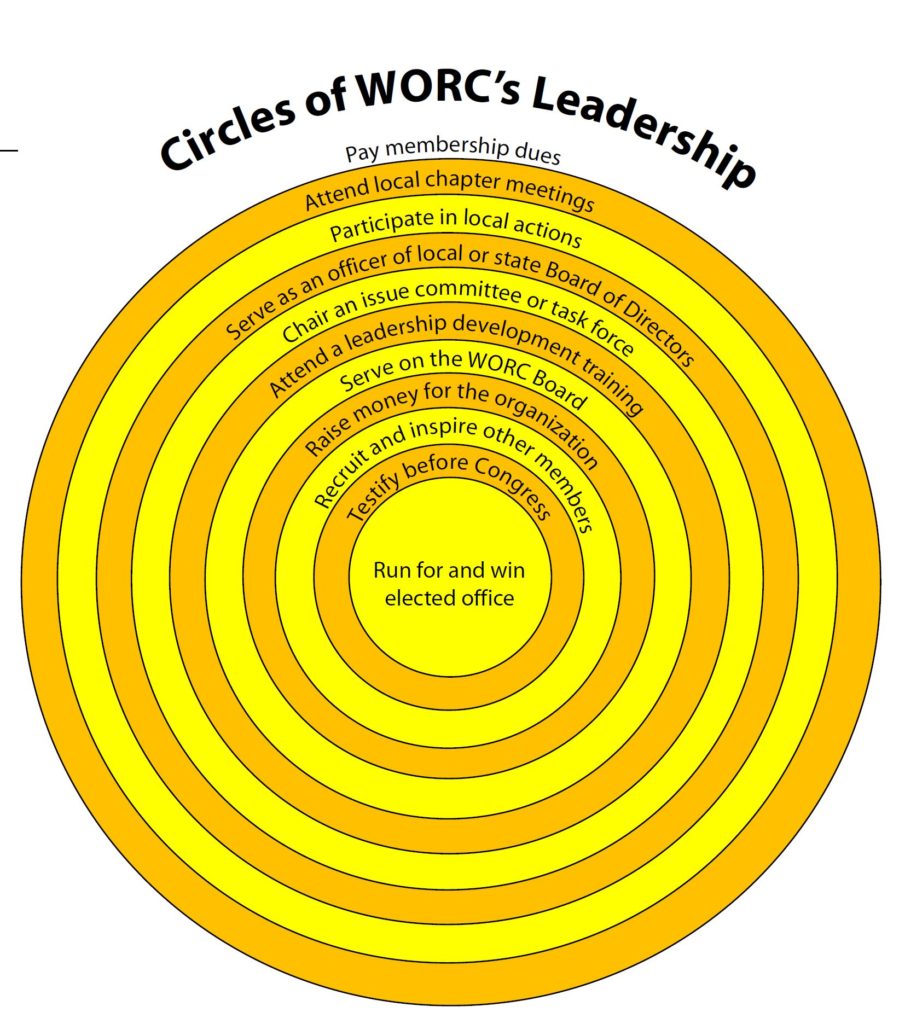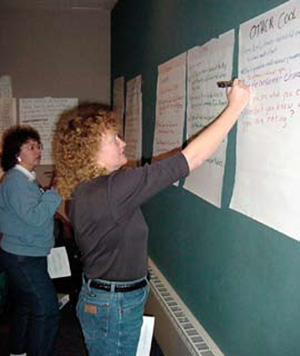How to Find and Develop Leaders
Finding and developing leaders
One concept that is central to community organizing is that of finding and developing leaders. By leaders we mean in a nutshell those people who bring out the best in others, communicate well and often, are accountable and responsible, and understand how to be a team player.
We need leaders of this sort for a very practical reason: to build organizations that maximize the participation and power of our members to achieve social change.
Qualities to look for in a leader
Leadership in community organizing is a function, not a person. In other words, anyone can be a leader with the right encouragement and support.
Community organizations need leaders. What makes a leader? Here are some of the qualities and characteristics to look for. Good leaders:
- Have a following – Lone wolves do not make good leaders. Leaders are adept at motivating others to take action and get involved.
- Are team players – Leaders know how to get the best out of a group of people, and build esprit de corps.
- Are self-confident – Leaders must be able to accept criticism and respond to challenges.
- Are good listeners – Leaders listen at least as much as they talk, to understand peoples’ values and concerns.
- Walk the talk – The best leaders lead by example, and no task is beneath them. Deeds speak louder than words.
- Take risks – Leaders have the courage to take action, even when the outcomes are uncertain.
- Are angry/persistent – Leaders have a “fire in the belly” that fuels their passion and commitment.
- Are accountable – Leaders keep their commitments and agreements, and take responsibility for their own actions. Their word is as good as gold.
- Are humble – A good leader is not a glory hog. He/she knows when to step aside and give others a chance.
- Have good judgment – Judgment is different from having an opinion. It involves taking many perspectives into consideration and making wise decisions.
- Have a sense of humor – Leaders know that humor is a potent force, and they do not take themselves too seriously
Who do you know who possesses all of these qualities? Most likely the answer is no single person. Community organizations need many people to step up and assume leadership roles. We call this approach shared leadership.
Shared leadership helps an organization use the talents and capabilities of all of its members. Shared leadership:
- arouses peoples’ interests,
- helps unify the group,
- enhances the likelihood that people will follow through with their commitments, and
- helps people develop their skills.
One leader’s journey
Peggy Utesch and her husband, Bob, purchased their dream property in 1999 in the Divide Creek area of Garfield County in western Colorado. Their dream was interrupted in 2002 when Encana, the largest natural gas company in North America, began drilling hundreds of wells in Garfield County. Within three years, more than 24 natural gas wells had been drilled within a mile of Peggy’s home.
Peggy decided to translate her anger into action. She started attending meetings of the Grand Valley Citizens Alliance (GVCA) and soon became a member.
Before long, Peggy was actively involved in organizing community forums, publishing a GVCA newsletter and writing educational brochures on responsible oil and gas development. She was elected a GVCA officer. Then she spearheaded a collaborative effort that brought together a drilling company and three local communities to hammer out a plan for responsible oil and gas development that was endorsed by U.S. Senator Ken Salazar and the three towns of Rifle, Silt and New Castle.
Peggy participated in trainings and workshops to improve her skills, and put them to work by coordinating an on-the-ground citizen enforcement program, and lobbying at the Colorado legislature.
Peggy became part of a larger statewide and national movement for change through her participation in the Western Colorado Congress and the Western Organization of Resource Councils. Peggy has twice testified before Congress on responsible oil and gas development.
What makes Peggy tick? “As long as I see injustice in the world I need to act,” she says, “and organizations like those in the WORC network empower people like me to make a difference.”
Community organizations find leaders from within
An important principle of community organizing is that all people can speak and act for themselves if given the respect and opportunity. When people act on their vision and values and come together to achieve social change in their communities, they are exercising true leadership.
Leadership of this nature does not require someone to be rich and powerful, well educated, a celebrity, or charismatic. It does not require a special degree or outstanding oratorical skills. In community organizing, anyone can be a leader.
Community organizations develop potential leaders from within their membership. Get a copy of your membership list, sit down with some existing leaders and review it. If you have a data base that keeps track of your members’ interests and skills that’s even better. Review the membership list, discuss what you know about each person on that list, and select 10, 20 or 50 names off that list for 1-on-1 conversations.
Remember, strong relationships build strong organizations, and when it comes to building relationships based on trust and respect, there’s no substitute for face-toface communication.
Divide up the list of members you’ve identified, go meet with them, and come back together as a group to reflect on what you’ve learned and determine your next steps.
More members mean more leaders
The larger a community organization’s membership base, the more people you have to talk to and the more likely you are to find leaders to develop. This is the important work of base building. People likely to join our organizations and eventually move into a leadership role include those who:
- are directly affected by the issues we work on,
- write sympathetic letters-to-the-editor,
- sign petitions circulated by our organizations,
- attend our meetings, actions and events,
- contribute to other like minded organizations, and/or progressive political candidates,
- call in or stop by our office,
- are friends and family of current members, and
- write letters to public officials on our issues
Leaders’ roles differ from organizers’ roles
Organizers should take care not to blur the boundaries of their role or responsibilities, or take on the roles of a leader.
- Organizers get paid by the organization, leaders do not.
- Organizers help guide decision making, but they do not make organizational decisions.
- Organizers work mostly behind the scenes. Leaders publicly represent the organization at actions and with the media.
- Organizers do their fair share of the work, but they try not to do things for others that they are capable of doing themselves.
An organizer must be comfortable knowing that s/he will be in the background and that when recognition comes, it’s from the members and leaders of the organization, not from newspapers or TV.
Leadership development is a process
Leadership development is a process, not a single event. It is a process that takes someone from writing an initial membership check to holding elected or appointed office.
Leadership development can be visualized as a series of concentric circles, where members move from the outer edges into the center and are surrounded by everyone else in the organization. An analogy would be a cocktail party in a small apartment. You arrive at the party, walk in the door, and hang out around the edges. As you meet people and become better acquainted, you move closer to the center, where the life of the party is.
People follow this path of leadership in community organizations not because of their genetic makeup, but because they want to develop their skills.
They attend training sessions, conferences and workshops, and apply and share what they’ve learned.
They learn through experience. They do the work of the organization, take some risks, and then evaluate what went right, what went wrong, and what they will do differently in the future.
And they continually search for ways to practice and improve their skills though individual work and study.
Training develops leaders
Leadership training is group training. Training sessions include time for people to get to know one another, try out leadership roles, and test their skills in a safe place before applying them in public.
- If a community organization plans to hold a press conference, a practice session or dry run for spokespersons and other members can be very helpful before stepping out in public. The speakers can rehearse their statements, members of the “audience” can discuss and agree on their roles, and the entire group can plan for “What ifs?”
Leadership training draws ideas from the group, and respects the talents and energies of the participants. Leadership skills are based on common sense, not specialized knowledge. Training sessions are designed to draw out the collective wisdom and knowledge of the participants.
- If a community organization is about to undertake a membership recruitment drive, the organizer should ask the members of the recruitment committee why they think people do and don’t join, and use this knowledge to help shape the recruitment efforts.
Leadership implies the ability to act. The test of effective training lies in people’s ability to act as a result. Good training incorporates a range of facilitation techniques that enable people to practice their leadership skills.
- When WORC leaders “fly-in” to Washington, D.C., participants are required to attend a day long orientation and training where they are briefed on the issues and message, schooled in effective lobby techniques, and assigned to lobby teams. The training includes policy presentations, 1-on-1 activities, and role play exercises. The next day, the lobby teams apply what they’ve learned in meetings with their Congressional representatives
Leadership implies the ability to reflect. People are not passive recipients of training, but actors in it. All good leadership training includes reflection on and evaluation of the training experience.
- Any leadership training worth its salt will build in multiple evaluation opportunities. WORC and its member groups are constantly adapting and revising their training methods and techniques based on feedback from participants.
Leadership training is most valuable when it is applied. A training session should not be held just for the sake of holding a training session. The content of a session is best when it is tied to what the group is actually doing or plans to do
- A community organization in Mesa County, Colorado was engaged in a campaign to pass a local watershed protection ordinance. Eight members attended a “message and media” workshop, one objective of which was to write a media plan for the campaign. Implementing the media plan that was written at the workshop earned broad coverage of the group’s campaign on radio, TV and in the newspapers.
Much of what a community organization ultimately accomplishes rises and falls on the character and competence of its leaders. Leadership is essential to getting things done. Leadership is about unlocking the potential of individual members and the organization, and inspiring people to come together, see what they are capable of, and helping them get there. Together there is nothing in this world we cannot do.
WORC would like to thank Kentuckians for the Commonwealth, the Washington Rural Organizing Project and the Southern Empowerment Project for their contributions to this How To.

Help create a healthy and sustainable West. Support WORC today.


